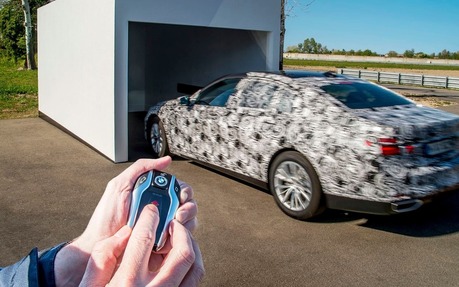BMW's Remote Control Parking System
Are parking spots too narrow? Or are modern vehicles simply too large? BMW’s answer to both these questions is: indeed.
The German manufacturer was in Montreal in mid-January to premiere the new and fairly large 6 Series Gran Turismo hatchback. It also unveiled a smart key which partly solves that parking dilemma, via its Remote Control Parking System function. That technology was first introduced last year on the 7 Series sedan, but since this one is often piloted by a chauffeur, it seemed less useful than on a car its owner will actually drive.
So, instead of designing smaller cars that would fit more easily in the tiny parking spaces designed in a not-too-distant past when cars where narrower, BMW proposes this modest form of autonomous driving. It allows exiting a vehicle before the vehicle parks itself in a space too small to fully open its doors.
The only requirement is for the driver to get the vehicle in front of the desired parking space, which has to be at least 9 feet wide, turn off the engine, and get out with the key in hand. A rather large touchscreen makes this key look like an iPod, but it is more than a mere gadget, since it can remotely trigger and monitor the car’s self-parking system.
By pressing a button, then the proper arrow icon on the display, the driver activates the system, which will first measure and evaluate the room around the vehicle, then get into the empty parking space in front (or behind) said vehicle.
All this takes mere seconds. BMW’s parking system can also take care of on-street parallel parking, but the driver needs to stay in the car.

Mission 2021
For BMW, this technology embodies its ambitious goal of putting a fully self-driving car on the roads by 2021 at the latest. “It’s coming fast,” warns Shawn Stephens, director of strategy and planning at BMW Canada.
Indeed. As early as next year, BMW hopes to launch a car able to drive by itself on long highway stretches, which accounts for the third of five levels of self-driving technologies (the fifth one being the one where there are no pedals and steering wheels). There’s only one condition: that the Canadian laws allow this to happen.
The technology is ready, assures Mr. Stephens. The only missing part is the ability to test-drive the technology on icy Canadian roads, so that it can optimize its behavior when the system loses track of the lines separating the different lanes. It obviously needs to be safe at all times when it operates…
In the meantime, at least, some BMW owners exhausted by their daily commute will get the chance to let their car park itself when they get to their destination. Next step would be to summon up the vehicle so it automatically picks you up at the office door. One day, hopefully…
